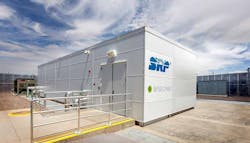New Ways to Deploy Edge Capacity for Data Center Leaders
This is the first entry in a four-part Data Center Frontier special report series that explores edge computing from a data center perspective. This post serves as an introduction to why data center leaders are looking for new ways to deploy edge capacity for their facilities.
Download the full report.
Data center leaders are actively looking at new ways to deploy edge capacity and support evolving business as well as user requirements. Are they actively investing in edge solutions? They absolutely are.
The latest AFCOM State of the Data Center Industry study found that edge solutions are a top-of-mind priority for data center leaders. About 44 percent say they have already deployed some form of edge computing capacity or will be doing so over the next 12 months. Another 17 percent already have it in their plans over the course of 3 years.
Four in 10 AFCOM respondents have either deployed or planned to deploy edge compute capacity. The typical respondent plans for the following estimated mean number of edge locations over time: 5.6 currently; 6.4 within 12 months; and 12.2 within 3 years.
Even more interesting is the amount of density within edge data centers. The estimated mean average power density in edge compute deployments is 6.7kW per rack, an indicator that these are more converged solutions and very dense environments. This also requires the delivery of more intelligent, robust, and agile edge computing systems.
Before we go on; let’s define edge, at a high-level, and really understand why all of these trends are actually happening.
The goal of Edge Computing is to allow an organization to process data and services as close to the end-user as possible.
An edge architecture allows the compute and content delivery process to happen within 10 milliseconds or less for the user. So, why is edge becoming one of the hottest technologies in our market? Because users are demanding it now, and new technologies will generate even more demand. The emerging explosion of connectivity and mobility makes a compelling case that investing in edge is an action item for right now.
What technologies are driving this? According to a recent Cisco report:
4G wireless systems are already growing constrained. Cisco’s Mobile report shows that in 2016, 4G already carried 69 percent of the total mobile traffic and represented the largest share of mobile data traffic by network type. It will continue to grow faster than other networks to represent 79 percent of all mobile data traffic by 2021. This is why future 5G connectivity with its very high bandwidth (100 Mbps) and ultra-low latency (1 millisecond), is expected to drive very high traffic volumes.
Smartphone traffic will exceed PC traffic by 2021. In 2016, PCs accounted for 46 percent of total IP traffic, but by 2021 PCs will account for only 25 percent of traffic. Smartphones will account for 33 percent of total IP traffic in 2021, up from 13 percent in 2016. PC-originated traffic will grow at a CAGR of 10 percent, while TVs, tablets, smartphones, and Machine-to- Machine (M2M) modules will have traffic growth rates of 21 percent, 29 percent, 49 percent, and 49 percent, respectively.
Traffic from wireless and mobile devices will account for more than 63 percent of total IP traffic by 2021. By 2021, wired devices will account for 37 percent of IP traffic, while Wi-Fi and mobile devices will account for 63 percent of IP traffic. In 2016, wired devices accounted for the majority of IP traffic at 51 percent.
Global mobile data traffic grew 63 percent in 2016. Global mobile data traffic reached 7.2 exabytes per month at the end of 2016, up from 4.4 exabytes per month at the end of 2015. (One exabyte is equivalent to one billion gigabytes, and one thousand petabytes.)
Mobile devices and connections: Almost half a billion (429 million) mobile devices and connections were added in 2016. Smartphones accounted for most of that growth, followed by M2M modules. Global mobile devices and connections in 2016 grew to 8.0 billion, up from 7.6 billion in 2015.
Mobile network (cellular) connection speeds grew more than 3-fold in 2016. Globally, the average mobile network downstream speed in 2016 was 6.8 Megabits per second (Mbps), up from 2.0 Mbps in 2015.
To keep up with the profile and characteristics of user demand, the ethos of data center infrastructure design, implementation, and management will evolve from redundancy to speed. In effect, “slow is the new ‘down.’” And, this is a major reason why so many leaders in the data center space are adopting edge solutions.
Market adoption around edge solutions
Edge computing services are being deployed within a number of different industries. For example, industrial IoT has been gaining a lot of traction. IDC recently predicted that by 2019, 45% of IoT-created data will be stored, processed, analyzed, and acted upon close to, or at the edge of, the network.
In working with manufacturing customers, we’re seeing how they’re bringing analog devices into the digital world. Sensors, machines, mobile devices are becoming a bigger part of the manufacturing world. In these cases, bringing data and applications closer to devices is critical.
From the customer’s perspective, edge computing can be any services or architecture which helps you simplify and localize the delivery of applications, data sets, and services.
On the topic of data, we’re generating a LOT of it, and more is being processed at the edge. According to Gartner, around 10 percent of enterprise-generated data is created and processed outside a traditional centralized data center or cloud. By 2022, Gartner predicts this figure will reach 50 percent. This means that services around edge will continue to evolve and grow. Remember, from the customer’s perspective, edge computing can be any services or architecture which helps you simplify and localize the delivery of applications, data sets, and services.
Here’s the bottom line: The edge will impact your business, whether you’re planning for it or not.
Many digital business projects create data that can be processed more efficiently when the computing power is close to the data source. Edge computing solutions address this need for localized computing power. IT infrastructure and operations (I&O) leaders tasked with managing these solutions should understand the associated business value and risks.
So, let’s talk about design. New technologies like 5G (we’ll talk about this a bit later) are helping transform the way edge and branch data centers are being leveraged. Furthermore, leading organizations have fundamentally simplified the way edge is being deployed and how quickly organizations can start to leverage the services. This is why it’s critical to work with the right solutions to make your own edge architecture successful.
Existing centralized data center infrastructure technology can’t deliver the speeds needed at the Edge. Fooling yourself into trying to make it perform that way will only result in astronomical bandwidth costs.
Now that we have your attention — there’s good news around edge design and deployment. And, this paper will outline the world of connected devices, explain how to get started, and even includes a checklist to follow when starting your own edge project!
In this special report series, we’re going to explore the practical approach to deploying an edge solution and how to simplify the entire deployment process. Specifically, we’ll cover:
- The edge requirement: Why so many are investing in edge solutions for competitive advantages.
- Understanding all of the ‘things’ connecting into an edge ecosystem.
- Overcoming operational challenges and understanding that traditional technologies from the data center can’t make up the edge.
- The true flexibility of the edge, and how it can quickly respond to shifting consumer demand.
- Deploying edge: A Lego-inspired, building block approach.
- Getting started (A checklist) — How to quickly become a part of the edge revolution.
Existing centralized data center infrastructure technology can’t deliver the speeds needed at the Edge. Fooling yourself into trying to make it perform that way will only result in astronomical bandwidth costs.
We’re going to cover edge design, practical best practices, and some real-world use-cases around edge computing. Most of all, we’ll examine a really cool Lego-inspired approach to rapidly deploying edge solutions!
This Data Center Frontier series, focused on edge computing, will also cover the following topics over the coming weeks:
- Understanding the Edge and the World of ‘Connected Devices’
- How to Leverage the True Flexibility of Edge and Where to Overcome Operational Challenges
- Deploying Real-World Edge Solutions: A Lego-Inspired Design Approach
To get immediate access to these insights, download the full Data Center Frontier Special Report on Edge Computing, courtesy of BASELAYER.
Explore the evolving world of edge computing further through Data Center Frontier’s special report series and ongoing coverage.
About the Author




